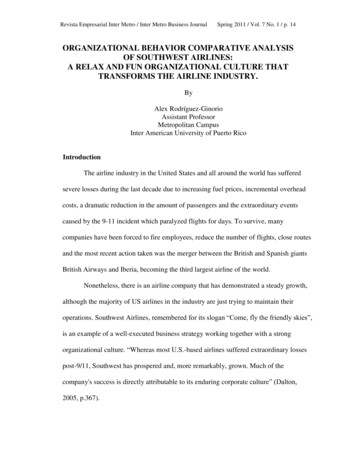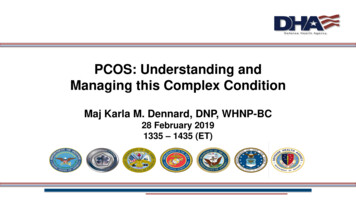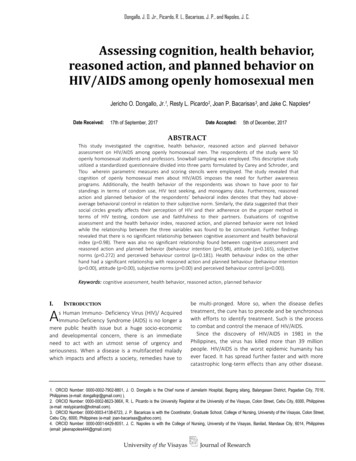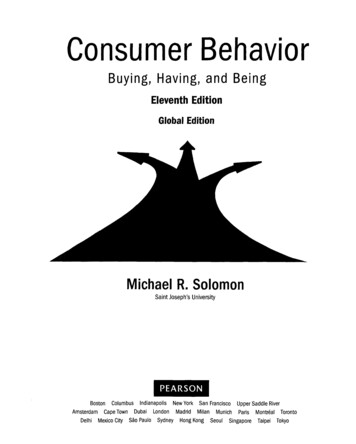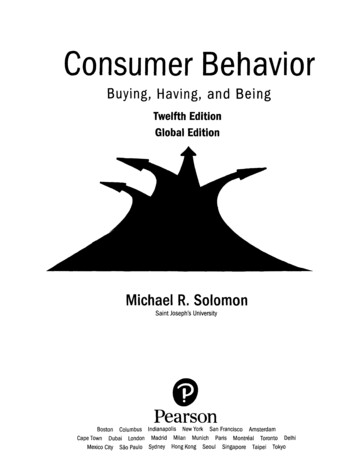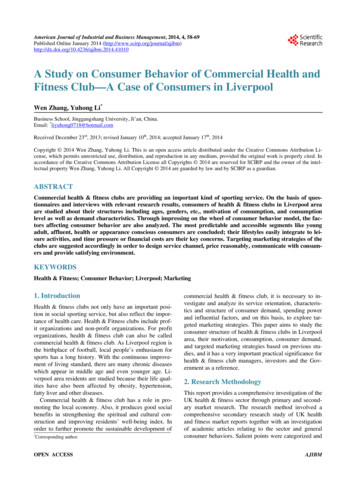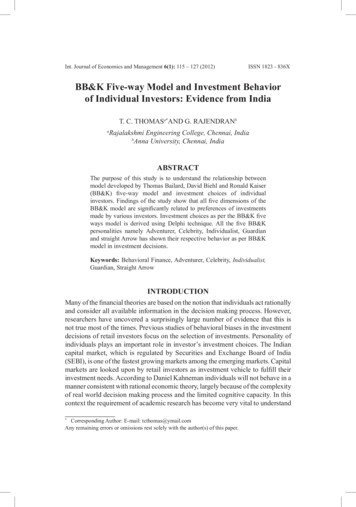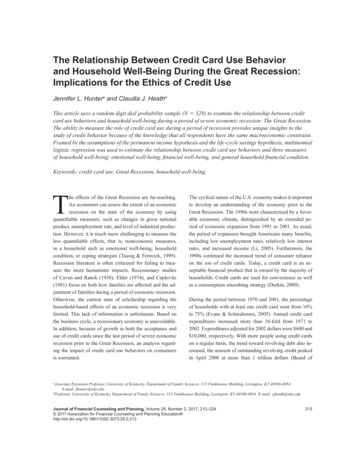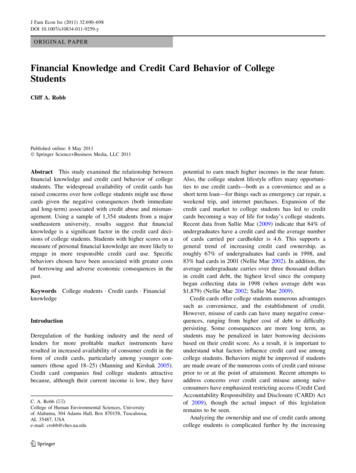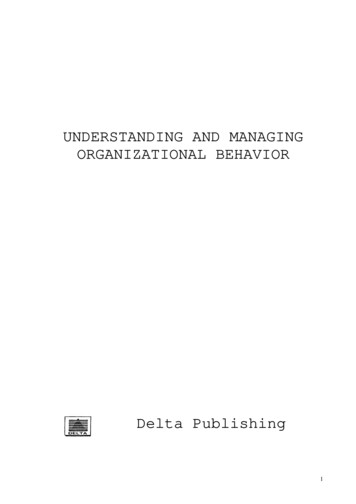
Transcription
UNDERSTANDING AND MANAGINGORGANIZATIONAL BEHAVIORDelta PublishingCompany1
Copyright 2006 byDELTA PUBLISHING COMPANYP.O. Box 5332, Los Alamitos, CA 90721-5332All rights reserved. No part of this book may be reproduced in any form orby any means, without permission in writing from the publisher.2
TABLE OF CONTENTSCHAPTER 1An Introduction to Organizational BehaviorCHAPTER 2Managing People and OrganizationsCHAPTER 3MotivationCHAPTER 4Work-Related AttitudesCHAPTER 5Organizational Communication and PowerCHAPTER 6Groups and Teams in OrganizationsCHAPTER 7LeadershipCHAPTER 8Prosocial Behavior, Cooperation Conflict, and StressCHAPTER 9Making Decisions in OrganizationsCHAPTER 10Culture, Creativity, and InnovationCHAPTER 11Designing Effective OrganizationsCHAPTER 12Managing Organizational Change and DevelopmentGLOSSARY3
CHAPTER 1AN INTRODUCTION TO ORGANIZATIONAL BEHAVIORLEARNING OBJECTIVESAfter reading this chapter you will be able to: Define organizational behavior. Trace the historical roots of organizational behavior. Discuss the emergence of contemporary organizational behavior, including itsprecursors, the Hawthorne studies, and the human relations movement. Describe contemporary organizational behavior—its characteristics, concepts, andimportance. Identify and discuss contextual perspectives on organizational behavior.What is an organization? An organization is defined as a collection of people who work togetherto achieve a wide variety of goals. Organizational behavior is defined as the actions and attitudesof people in organizations. The field of organizational behavior (OB) covers the body ofknowledge derived from these actions and attitudes. It can help managers understand thecomplexity within organizations, identify problems, determine the best ways to correct them, andestablish whether the changes would make a significant difference.In this chapter, we begin with a comprehensive definition of organizational behavior anda framework for its study. We then trace the field’s historical roots and its emergence as anindependent field. Next, we discuss contemporary organizational behavior and present anoverview of the rest of this book. Finally, we examine several contextual perspectives thatprovide the general framework from which we can develop a more comprehensive examinationof human behavior at work.The Meaning of Organizational BehaviorOrganizational behavior (OB) is the study of human behavior in organizational settings, howhuman behavior interacts with the organization, and the organization itself. Although we canfocus on any one of these three areas independently, we must remember that all three areultimately connected and necessary for a comprehensive understanding of organizationalbehavior. For example, we can study individual behavior (such as the behavior of a company’sCEO or of one of its employees) without explicitly considering the organization. But becausethe organization influences and is influenced by the individual, we cannot fully understand theindividual’s behavior without knowing something about the organization. Similarly, we canstudy an organization without focusing specifically on each individual within it. But again, weare looking at only one piece of the puzzle. Eventually, we must consider the other pieces tounderstand the whole.1
Exhibit 1 illustrates this view of organizational behavior. It shows the linkages amonghuman behavior in organizational settings, the individual-organization interface, theorganization, and the environment surrounding the organization. Each individual brings to anorganization a unique set of personal characteristics, experiences from other organizations, andpersonal background. Therefore, organizational behavior must look at the unique perspectivethat each individual brings to the work setting. For example, suppose that Texas Instrumentshires a consultant to investigate employee turnover. As a starting point, the consultant mightanalyze the types of people the firm usually hires. The goal of this analysis would be to learn asmuch as possible about the nature of the company’s workforce from the standpoint of theindividual—their expectations, their personal goals, and so forth.EXHIBIT 1THE NATURE OF ORGANIZATIONAL BEHAVIOREnvironmentINDIVIDUALHUMAN BEHAVIORINORGANIZATIONALSETTINGSTHE INDIVIDUALORGANIZATIONINTERFACETHE ORGANIZATIONBut individuals do not work in isolation. They come in contact with other people andwith the organization in a variety of ways. Points of contact include managers, coworkers, theformal policies and procedures of the organization, and various changes implemented by theorganization. Over time, the individual changes as a function of both personal experiences andmaturity and of work experiences with the organization. The organization, in turn, is affected bythe presence and eventual absence of the individual. Clearly, then, the study of organizationalbehavior must consider the ways in which the individual and the organization interact. Thus, theconsultant studying turnover at Texas Instruments might choose to look at the orientationprocedures for newcomers to the organization. The goal of this phase of the study would be tounderstand some of the dynamics of how incoming individuals interact within the broaderorganizational context.An organization, of course, exists before a particular person joins it and continues to existlong after he or she has left. Therefore, the organization itself represents a crucial perspectivefrom which to view organizational behavior. For instance, the consultant studying turnoverwould also need to study the structure and culture of Texas Instruments. An understanding offactors such as the performance evaluation and reward systems, the decision-making and2
communication patterns, and the design of the firm itself can provide additional insight into whysome people decide to stay while others elect to leave.Clearly, the field of organizational behavior can be both exciting and complex. Myriadvariables and concepts impact the interactions described, and together these factors can greatlycomplicate a manager’s ability to understand, appreciate, and manage others in an organization.However, they can also provide unique opportunities to enhance personal and organizationaleffectiveness. The key, of course, is understanding. To provide some groundwork forunderstanding, we look first at the historical roots of organizational behavior.Historical Roots of Organizational BehaviorMany disciplines, such as physics and chemistry, are literally thousands of years old.Management has also been around in one form or another for centuries. For example, thewritings of Aristotle and Plato abound as references and examples of management concepts andpractices. But because serious interest in the study of management did not emerge until the turnof the twentieth century, organizational behavior is only a few decades old.One reason for the relatively late development of management as a scientific field is thatvery few large business organizations existed until around a hundred years ago. Althoughmanagement is just as important to a small organization as it is to a large one, large firmsprovided both a stimulus and a laboratory for management research. Second, many of the initialplayers interested in studying organizations were economists. Economists initially assumed thatmanagement practices are by nature efficient and effective; therefore, they concentrated onhigher levels of analysis such as national economic policy and industrial structures rather than onthe internal structure of companies.Scientific ManagementOne of the first approaches to the study of management, popularized during the early 1900s, wasscientific management. Individuals who helped develop and promote scientific managementincluded Frank and Lillian Gilbreth (whose lives are portrayed in a book and a subsequentmovie, Cheaper by the Dozen), Henry Gantt, and Harrington Emerson. But the personcommonly associated with scientific management is Fredric W. Taylor.Early in his life, Taylor developed an interest in efficiency and productivity. Whileworking as a foreman at Midvale Steel Company in Philadelphia from 1878 to 1890, he noticed aphenomenon, which he named “soldiering”—employees’ working at a pace much slower thantheir capabilities. Because managers had never systematically studied jobs in the plant and, infact, had very little idea on how to gauge worker productivity, they were completely unaware ofthis phenomenon.To counteract the effects of soldiering, Taylor developed several innovative techniques.First, he scientifically studied all the jobs at the Midvale plant and developed a standardizedmethod for performing each one. He also installed a piece-rate pay system in which each workerwas paid for the amount of work he completed during the workday rather than for the time spenton the job. (Taylor believed that money was the only significant motivational factor in the3
workplace.) These two innovations resulted in a marked increase in productivity and serve as thefoundation of scientific management as we know it.After leaving Midvale, Taylor spent several years working as a management consultantfor industrial firms. At Behlehem Steel Company, he developed several efficient techniques forloading and unloading rail cars. At Simonds Rolling Machine Company, he redesigned jobs,introduced rest breaks to combat fatigue, and implemented a piece-rate pay system. In everycase, Taylor claimed his ideas and methods greatly improved worker output. His book,Principles of Scientific Management, published in 1911, was greeted with enthusiasm bypracticing managers and quickly became a standard reference.Scientific management quickly became a mainstay of business practice. It facilitated jobspecialization and mass production, consequently influencing the U.S. business system inprofound ways. Taylor had his critics, though. Laborers opposed scientific managementbecause of its explicit goal of getting more output from workers. Congress investigated Taylor’smethods and ideas because some argued that his incentive system would dehumanize theworkplace and reduce workers to little more than drones. Later theorists recognized thatTaylor’s views on employee motivation were inadequate and narrow. And recently there havebeen allegations that Taylor falsified some of his research findings and paid someone to do hiswriting for him. Nevertheless, scientific management represents an important milestone in thedevelopment of management thought.Classical Organization TheoryDuring the same era, another perspective on management theory and practice was also emerging.Generally referred to as classical organization theory, this perspective is concerned withstructuring organizations effectively. Whereas scientific management studied how individualworkers could be made more efficient, classical organization theory focused on how a largenumber of workers and managers could be most effectively organized into an overall structure.Major contributors to classical organization theory included Henri Fayol, LyndallUrwick, and Max Weber. Weber, the most prominent of the three, proposed a “bureaucratic”form of structure that he believed would work for all organizations. Although today the termbureaucracy conjures up images of paperwork, red tape, and inflexibility, Weber’s model ofbureaucracy embraced logic, rationality, and efficiency. Weber assumed that the bureaucraticstructure would always be the most efficient approach. (Such a blanket prescription representswhat is now called a universal approach.) A bureaucracy is an organizational structure in whichtasks are specialized under a given set of rules and a hierarchy of authority. Division of labor isthe separation of work loads into small segments to be performed by one or more people. In abureaucracy, tasks are assigned through the division of labor. A set of outlined procedures existsfor each job. Because these procedures are invariable, the tasks assigned for each job becomeroutine for the employee. Thus, creativity is low.In a bureaucracy, the standards for evaluating job performance do not need to be updatedbecause required tasks never change. However, this lack of variation leads to an impersonal work4
environment, lacking incentives for extraordinary task performance and ultimately limiting thegrowth potential of individual employees.In contrast to Weber’s views, contemporary organization theorists recognize thatdifferent organizational structures may be appropriate in different situations. As with scientificmanagement, however, classical organization theory played a major role in the development ofmanagement thought, and Weber'’ ideas and the concepts associated with his bureaucraticstructure are still interesting and relevant today.THE EMERGENCE OF ORGANIZATIONAL BEHAVIORThe central themes of both scientific management and classical organization theory arerationality, efficiency, and standardization. The roles of individuals and groups in organizationswere either ignored altogether of given only minimal attention. A few early writers andmanagers, however, recognized the importance of individual and social processes inorganizations.PRECURSORS OF ORGANIZATIONAL BEHAVIORIn the early nineteenth century, Robert Owen, a British industrialist, attempted to improve thecondition of industrial workers. He improved working conditions, raised minimum ages forhiring children, introduced meals for employees, and shortened working hours. In the earlytwentieth century, the noted German psychologist Hugo Munsterberg argued that the field ofpsychology could provide important insights into areas such as motivation and the hiring of newemployees. Another writer in the early 1900s, Mary Parker Follett, believed that managementshould become more democratic in its dealings with employees. An expert in vocationalguidance, Follett argued that organizations shou
2 Exhibit 1 illustrates this view of organizational behavior. It shows the linkages among human behavior in organizational settings, the individual-organization interface, the
